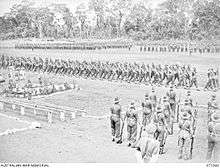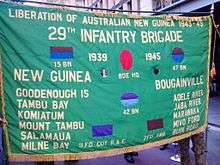29th Brigade (Australia)
| 29th Brigade | |
|---|---|
 A patrol from the 29th Brigade on Bougainville, January 1945 | |
| Active | 1941–45 |
| Country | Australia |
| Branch | Australian Army |
| Type | Infantry |
| Size | ~3,500 personnel |
| Part of |
5th Division (1941–44) 3rd Division (1944–45) |
| Engagements | |
The 29th Brigade was an infantry brigade of the Australian Army that was raised for service during World War II. Formed in late 1941 as part of the Militia, the brigade was initially formed for home defence in response to Japan's entry into the war. Composed of three Queensland-based infantry battalions and various supporting elements, the brigade initially undertook defensive duties around Townsville in 1941–42 before deploying to New Guinea in 1943. There, the brigade undertook garrison duties before taking part in the Salamaua–Lae campaign. After a period of almost 18 months overseas, the brigade's elements were returned to Australia for a period of rest and reorganisation before later being assigned to the Bougainville campaign in 1944–45. After the war, the brigade was disbanded in December 1945, along with its component units.
History
Raised on 20 December 1941 under the command of Brigadier Thomas Louch[1] for service during World War II, the 29th Brigade was formed as part of the Militia, Australia's part-time military force. Initially tasked with defending Townsville against possible invasion from the Japanese, in March 1942,[2] the brigade's three infantry battalions—the 15th, 42nd and 47th Battalions—began concentrating in Tiaro where they formed part of the 5th Division.[3] In April 1942, the brigade began moving to Townsville to take up defensive duties, constructing defences along line between Giru and Rollingstone.[4] During the Battle of Coral Sea, when the threat of invasion seemed imminent, the brigade was moved to the coast, issued ammunition for the first time and stood-to in preparation for a Japanese landing. In the event, this invasion did not occur and the brigade was stood down, returning to more mundane garrison duties,[5] before moving to Mount Spec, to undertake jungle training in preparation for overseas service.[4]

In January 1943, with the threat of invasion over, the brigade was deployed to New Guinea,[6] under the command of Brigaider Ray Monaghan. With the 42nd Battalion moving to Gilli Gilli and Rabi, near Milne Bay, to relieve the 7th Brigade's 61st Battalion, which had fought a successful defensive action there against the Japanese the previous year during the Battle of Milne Bay.[5] Meanwhile, the 47th Battalion garrisoned Goodenough Island and the 15th Battalion was stationed at Buna initially before later moving to Morobe.[4][7]
The brigade was later committed to the Salamaua–Lae campaign in August 1943, taking part in the fighting around Nassau and Tambu Bays, in support of the advance on Salamaua. Throughout late August and early September, the 15th Battalion launched an attack around the right flank of the US 162nd Infantry Regiment, against a Japanese position along the Lokanu and Scout Ridges. Against steep terrain and heavy resistance, the battalion eventually took the ridge, securing it by 9 September.[8] Following up, on 9 September the 42nd Battalion attacked Charlie Hill as part of the final assault on Salamaua, which was captured several days later. Later, in early 1944, as the 7th Division advanced through the Markham and Ramu Valleys, the 15th Battalion assisted the division's operations around Lae, conducting patrols in the area until August 1944[6] when they were withdrawn to Australia for rest and re-organisation having been deployed for over a year-and-a-half. The brigade was then concentrated around Petrie and Strathpine, in Queensland, in preparation for further action overseas.[7] The brigade was subsequently assigned to the 3rd Division and 1944–45 took part in the Bougainville campaign.[6]
On Bougainville, the Australians had taken over from an American garrison in late 1944 in order to free up US troops for the fighting in the Philippines. Prior to their arrival, the US garrison had maintained a largely defensive posture, but the Australians launched a limited-scale offensive on the island which evolved into three main drives in the north, south and in the centre of the island. The 29th Brigade relieved the US 182 Infantry Regiment and was subsequently assigned to the southern drive towards Buin, where the main Japanese force was based.[9][10]
The 15th Battalion commenced the brigade's campaign on Bougainville, being committed to the fighting in December 1944, while the 42nd and 47th Battalions joined them later the following month. During the initial stages, the 15th Battalion patrolled along the western coast, clearing the Japanese from an area between the Jaba and the Tavera Rivers. In early January, the 15th Battalion married up with the 42nd and 47th Battalions and the brigade advanced to Mawaraka, fighting a series of minor actions in the jungle and swamps before it was relieved by the 7th Brigade in the middle of the month, at which time the 29th Brigade was moved back to the major Australian base at Torokina for rest.[4]
The 29th Brigade, now under the command of Brigadier Noel Simpson, who had taken over after Monaghan had been relieved of his command,[11] was committed for a second effort in early July 1945 advancing from the Mivo River to the Oamai River during the final stages of the campaign. Two companies from the 15th Battalion led the advance, setting out from Sisikatekori, while the 47th Battalion positioned a company along the river near a track dubbed "Lawne's Track", and the 42nd sat stride the Buin Road, just short of the Mobiai River. The brigade's efforts to secure a crossing over the Silibai River were frustrated by determined Japanese defence which held them up between 3 and 10 July, when the Australians successfully pushed their way across. Temporary positions were then established on the opposite bank and the patrols began ranging south towards the Oamai River; further advances, though, were hampered by heavy rain, which held up the advance on the Japanese strong hold around Buin until the end of the war.[4] The brigade's headquarters was disbanded in December 1945;[12] its component units subsequently returned to Australia where they were disbanded during the early months of 1946.[6][4][7]
Assigned units

The 29th Brigade typically consisted of:[13][14]
- Brigade Headquarters;
- 15th Battalion;
- 42nd Battalion;
- 47th Battalion;
- 11 Field Company RAE
- 7 Field Ambulance AAMC
- Supporting artillery, and other units.
Commanding officers
The following officers served as commanding officer of the 29th Brigade:[15][11]
- Brigadier Thomas Louch (1941–42);
- Brigadier Raymond Monaghan (1942–45);
- Brigadier Noel Simpson (1945).
References
- ↑ "29 Australian Infantry Brigade". Orders of Battle.com. Retrieved 6 April 2011.
- ↑ "29th Infantry Brigade". Australia@War. Retrieved 6 April 2011.
- ↑ "29 Australian Infantry Brigade: Superiors". Orders of Battle.com. Retrieved 6 April 2011.
- 1 2 3 4 5 6 "42nd Battalion (Capricornia Regiment)". Second World War, 1939–1945 units. Australian War Memorial. Retrieved 18 June 2015.
- 1 2 "42nd Australian Infantry Battalion". Australia@War. Retrieved 19 June 2015.
- 1 2 3 4 "15th Battalion (Oxley Regiment)". Second World War, 1939–1945 units. Australian War Memorial. Retrieved 6 April 2011.
- 1 2 3 "47th Battalion (Wide Bay Regiment)". Second World War, 1939–1945 units. Australian War Memorial. Retrieved 26 June 2010.
- ↑ Dexter, David (1961). The New Guinea Offensives. Australia in the War of 1939–1945. Series 1—Army. Volume VII (1st ed.). Canberra, Australian Capital Territory: Australian War Memorial. pp. 304, 308 & 316. OCLC 2028994.
- ↑ Keogh, Eustace (1965). South West Pacific 1941–45. Melbourne, Victoria: Grayflower Publications. pp. 396, 417–422. OCLC 7185705.
- ↑ Park, William (2010). Beyond Adversity: 'U' Company, 15th Battalion 1941–1942. Newport, New South Wales: Big Sky Publishing. p. 95. ISBN 978-0-9806582-7-9.
- 1 2 James, Karl (2012). The Hard Slog: Australians in the Bougainville Campaign, 1944–45. Port Melbourne, Victoria: Cambridge University Press. pp. 238–239. ISBN 978-1-107-01732-0.
- ↑ "AWM52 8/2/29/43: 29th Infantry Brigade: September – December 1945". Unit War Diaries. Australian War Memorial. Retrieved 18 June 2015.
- ↑ "29 Australian Infantry Brigade: Subordinates". Orders of Battle.com. Retrieved 6 April 2011.
- ↑ "29th Australian Infantry Brigade". Monuments Australia. Retrieved 20 June 2015.
- ↑ "29 Australian Infantry Brigade: Appointments". Orders of Battle.com. Retrieved 6 April 2011.
Further reading
- Benson, S.E. (1952). The Story of the 42 Aust. Inf. Bn. Sydney, New South Wales: Dymock's Book Arcade for the 42nd Australian Infantry Battalion Association. OCLC 35362463.
- Weber, E.C. (1990). The 47th Battalion (A Tribute) and the 47th Battalion Memorial Trophy and Rugby League. Maryborough, Queensland: E.C. Weber. ISBN 9780731684861.